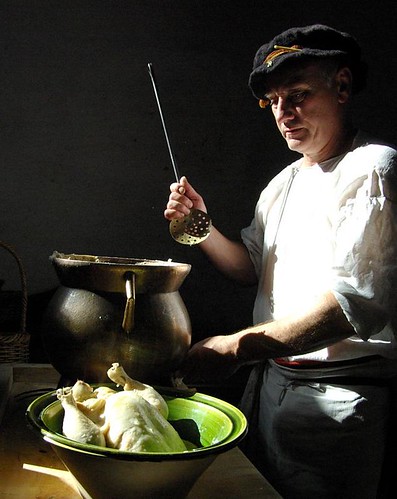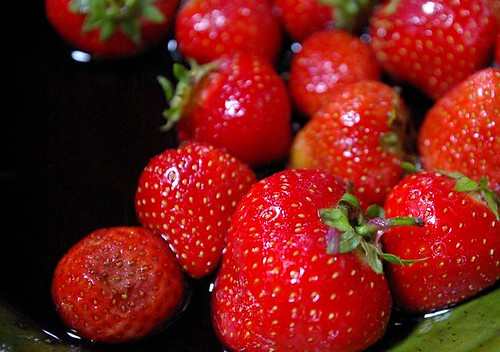To go with the post below, Robert also sent 9 pictures which are now there for all to see at Flickr......just follow the link on the right to get there!
They include these gems.....



This is the blog of the Tudor kitchens cookery project at Hampton Court Palace, Surrey, England. It's not an official blog and only represents how I see the stuff we do...enjoy
To go with the post below, Robert also sent 9 pictures which are now there for all to see at Flickr......just follow the link on the right to get there!
They include these gems.....



was the subject line of the email from Robert as he sent me his copy for this posting. He knows that he has the login and posting details, but he's an old fashioned chap and likes to run it all through me first....bless him ;-)
So, here are his words.......
Hello again!
For most of the summer I have been meaning to update the blog, but the further away you get, the more difficult it becomes to catch up. So, like the usual desperate twist in generic science fiction, how about taking the year backwards? The advantage; at least we can remember what happened last weekend. And the other advantage is that as the blog goes deeper into the past it will get even more out of joint, and possibly slightly surreal...
Although, the year has been rather strange anyway, with a wedding every day and tournaments, coronation celebrations and all sorts of revels. Usually the music plays in the distance and the boys peer forlornly up at the small patch of blue that we call the sky... but for a couple of times we were released from the vaults and frolicked like pit-ponies in the sun...
Well, that wasn't such a good image after all, just as well last weekend was a 'normal' one.
Saturday 26th September.
For a change, we repeated something! As we are trying to be serious about our research remit, we have been doing a lot of measuring. We have tried a few approaches, but it's not easy to know where to start. So, we chose something that is reliable to do, gives proper figures and doesn't second guess 'interesting' results. Every main meal, the 'supper' in the afternoon, has the food weighed before and after. The idea started when we were trying to work out the 'bouch of court' meat ration, not as easy as you might think as the quantities recorded are monetary, not by weight.
When Richard had worked it out, it seemed an awful lot, and that got us thinking about how much we ate anyway. Although it is something we have vaguely wondered about since we started, as the style of Tudor dining; just taking what you want, in small portions, over the course of the meal, does mean you lose count, and only stop when you are satisfied. Or think you are. A bit like surfing a buffet and only later realising one is too full for beer. Not that this happened to me at Ross's wedding...
So to have a set of meaningful figures we decided that the September cooking weekend would feature the same dishes as we had in July. Time's arrow will explain why we chose these dishes in the first place, as the blog moves deeper into the past... It turned out to be an interesting experiment; we usually try to vary what we cook, and having to repeat a whole day gave us a chance to make the dishes even better.
Roast Beef
Salmon Fress Boiled
Capon Stewed
Ryse of Genoa
Strawberye
Of course we have to have roast beef, and it was as good as always, we ate an average of 130 grams each; a modern restaurant portion is around 100grams.
The salmon was roasted on a gridiron, then boiled with parsley and salt, then served with a garnish of parsley leaves wetted with vinegar, we managed 50 grams of that.
We had to use chicken for the capon stewed, as it isn't easy to get capon nowadays; capons are made, not born, unfortunately [now you remind me Robert, we might be able to get some sorted for Christmas]... But this is a great recipe: stuff the chicken with roughly broken herbs and put it into a pot, which has 'broken splints' (we used wooden spoons) placed inside so that the bird 'touche no thinge of the potte'. Then put in herbs (including hyssop) and some of 'the best wyn that thou may gete and none other licour', the lid is sealed on with sticky dough 'that no eier come oute' and put on the stove 'easly and longe till hit be ynowe'. Then make a sweet, fruity syrup with the wine and 'powre hit on the capon'. Chicken steamed in wine; well of course it was nice!
Ryse of genoa is one of our standards, it turns up in about one in four of our cooking days over the last few years, being a useful non-meat dish. This time it was particularly good, one of the bowls was completely finished. Thought it may be interesting to go into a bit of detail into the making of this sometimes overlooked staple.
'take Ryse ans seth them in fayre water ans stepe them well And take hem of and caste them in A fayre vessell and pyke them clene and set then on fyre A yene'. Does this mean the rice is boiled before any stones and husks are removed? A similar recipe from a 1500 book is more explicit; 'To make ryse, pyke youre ryse and wasshe it in [two] or thre waters and late the water be warme', an older Forme of Cury version is typically direct, 'Take ryse and waisshe hem clene'. Our recipe goes on, 'And do ther to broth of freshe beef or of mary bones and let hem seth well And do there to grownd safferon & salt and if hit be fastyng day temper hit with Almound mylke & serue hit forth.'
Boiled twice? The Forme of Cury version just has the rice boiled in stock. The 1500 book recipe is less vague, 'And boyle hem in clene water and at the first boyle put out the water clene and boyle them with the brothe of flesshe or with brothe of fresshe fisshe and put therto sugar saffrom and salt and serue it'. We know that this dish is more like risotto than rice pudding, because it would say so; compare with another Forme of Cury recipe for a pottage of rice which has, 'and seth hem tyl they breste [burst]'
So how did Robin make it so good? This week I secured an exclusive interview with the Maister himself...
He said that as we have been making it so long he has tried all sorts of rice, long and short grain and in the early days used stock made up from stock cubes (one beef, one vegetable, made up to double strength). This weekend he used stock he had made earlier this year, at one of the events when we didn't do much cooking. Beef bones and trimmings simmering in a cauldron all day until it had reduced from a gallon to under two pints. When cold, the fat skimmed off, and then frozen to use later.
This time he used arborio risotto rice, the label said, 'bold, white grains characteristic of Milanese rice, typical of northern Italy', (presumably Genoa being the port where the rice was exported from; none of the other rice recipes gives even a clue like this what type of rice is intended to be used). Wash the rice, and boil in plenty of water until half cooked, then refresh in cold water. Bring the stock up to the boil, add the rice and boil together, and try to absorb as much of the stock as you can. Robin adds the saffron as a solution; dry it over the stove on a spoon, then grind it fine in a mortar, which is washed with a little water which you then add to the rice. Try it for saltiness before serving, this time the stock was so concentrated, it didn't need any added salt. It was rich and tasty, and, as I may have mentioned, one of our messes finished the whole bowl, unusual for a dish we know so well.
The last dish was strawberye, which also involves rice, this time as rice flour to thicken. It too was much appreciated. As I have gone on a bit and Richard has described the process before in the blog, I'll leave strawberye until I can interview Marc H and get the low-down on what made it so good this time.
Next time, Sunday; and the return of the poumes!
